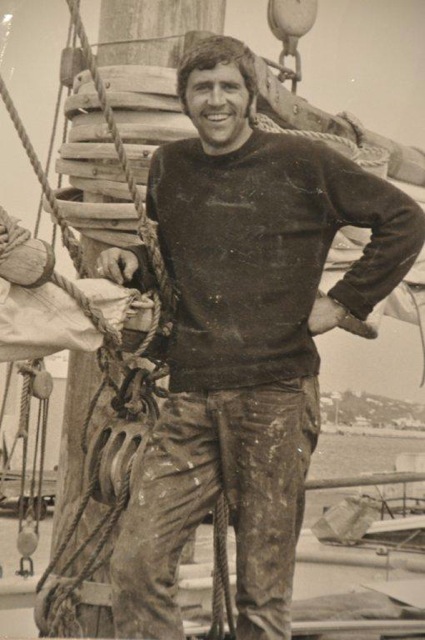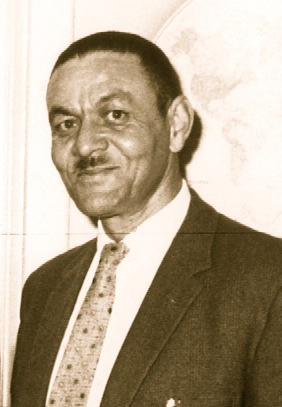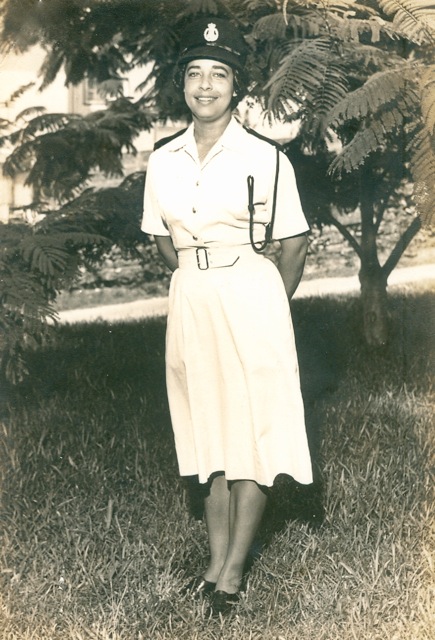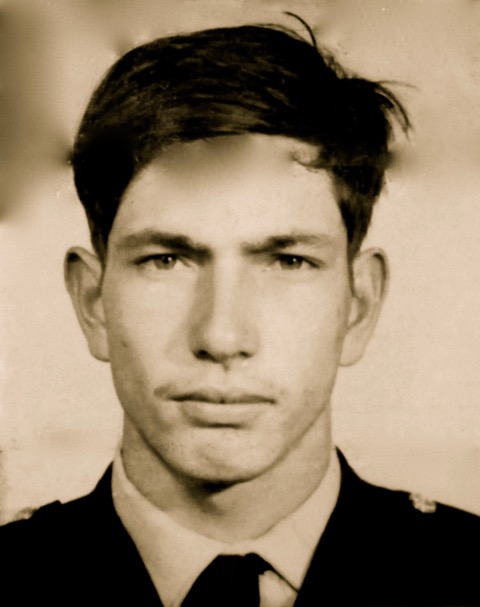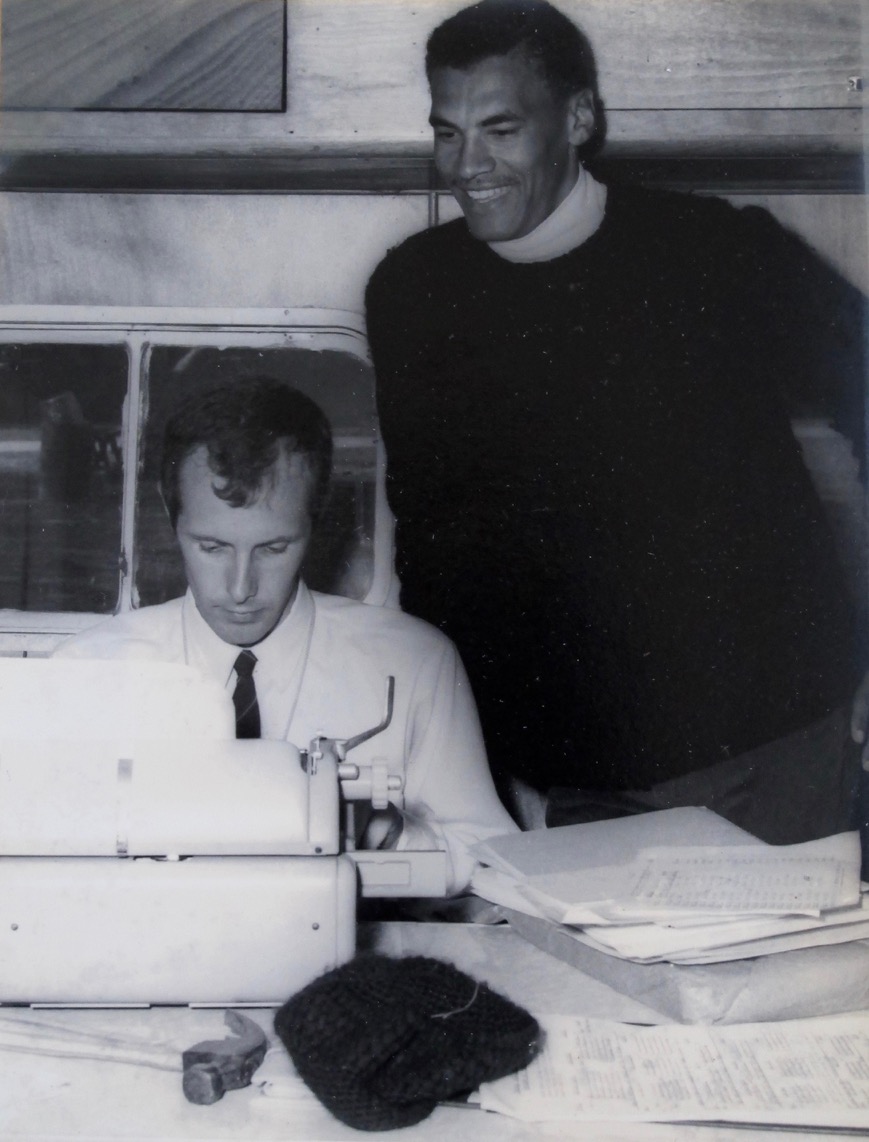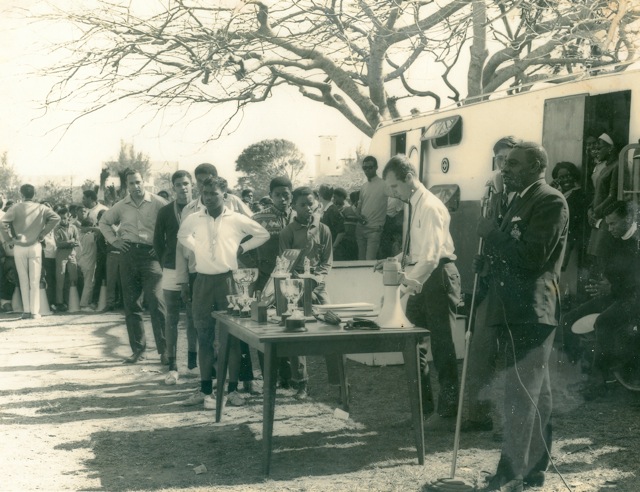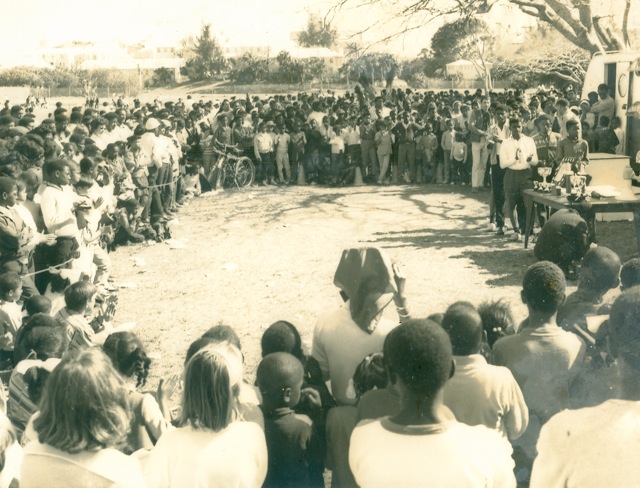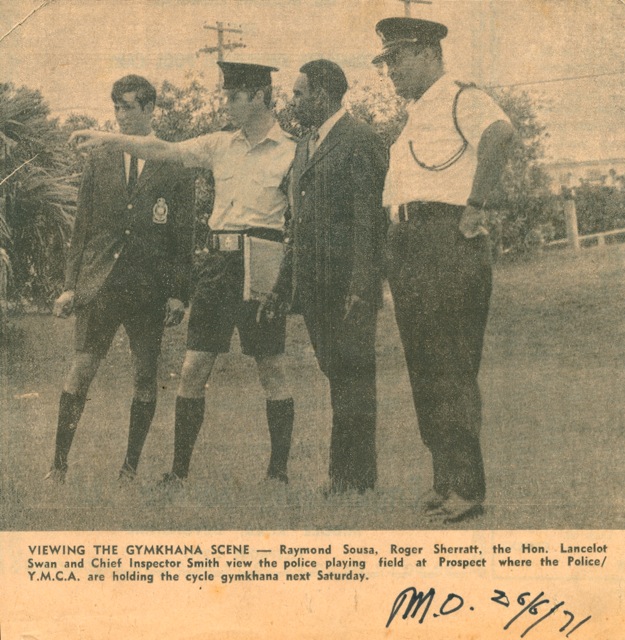Our Adventure on the Fletcher Christian
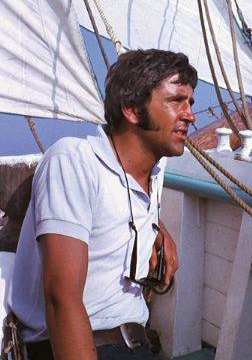
Mike Caulkett
Some time ago Roger Sherratt urged me to write an article about the ‘Fletcher Christian’ boat trip for ‘expobermuda’ when the website was still being developed. Tom Barnes, who I see regularly, has since covered aspects of the trip in his ‘Then and Now’ entry. So I apologise for any repetition.
Towards the end of 1969 I had been in Bermuda for over five years and was at the point where I was contemplating my future. Wine, women and song are fine but not every day forever! I was at a party (no surprise there) talking to a good friend of mine and fellow police officer, Jack Rouse. For those that didn’t know Jack, he was a Fijian who had been privately educated in England and was in all respects very British. He was also captain of the Police rugby team that I also played for and I liked and respected him greatly.
Jack casually asked me what I would be doing at the end of my next contract which would be in November 1970. I told him that I had been thinking about my future and hadn't yet made up my mind what to do. Should I stay in the Police in Bermuda, settle down and try for promotion, or return to the UK and rejoin the Police, or do something entirely different. The world was my lobster, as they don’t say. But I was fast approaching thirty and really should be making decisions about my future.
Jack then asked me if I fancied sailing on a Baltic Trader to Fiji the following spring. Did I? Of course I did. I told him ‘yes’ at that moment, without further consideration and without any idea what I was agreeing to and I didn't step back from that decision. Jack was very friendly with Des McSherry a Detective Sergeant he worked with in Special Branch who, along with his American wife Lucille, lived on and sailed their own boat, including buying it in America and, I believe, sailing it from there to Bermuda. Jack's family still lived in Fiji where they owned property.
Jack and Des, together with financial backing from American contacts, planned to buy, in Scandinavia, the Gaff Rigged twin masted schooner that you see in the photos, have it sailed to Bermuda by a professional crew where it would be fitted out to sail to Fiji via the Atlantic, Caribbean, Panama Canal and the Pacific, with Des as the skipper and a crew gathered together in Bermuda.
The long term plan was that a Cottage Colony similar to those found in Bermuda would be built in Fiji on land owned by Jack Rouse’s family and the boat, once in Fiji would be used in connection with that for the, mostly American, tourists staying at the Cottage Colony, day trips etc.
In the end three policemen, Tom Barnes, Eric Sanderson and myself volunteered to join Des’ crew with the remainder being made up of Des' wife Lucille; Jane, a nurse; Eric's girlfriend Sally; Russell a journalist, and Colin an engineer. Dave Ashurst, another police officer, joined the crew but just for the first stage of the trip to Puerto Rico, from where he would return to Bermuda. Why didn’t I think of that? A more inexperienced crew you could not imagine! Jack had more sense and planned to meet us in Fiji. I can’t speak for everyone but Tom and I agreed to pay £1.00 per day for the estimated 180 day trip. The boat duly arrived from Scandinavia early in 1970, its name was changed from Charlotte 111 to the ‘Fletcher Christian’ .
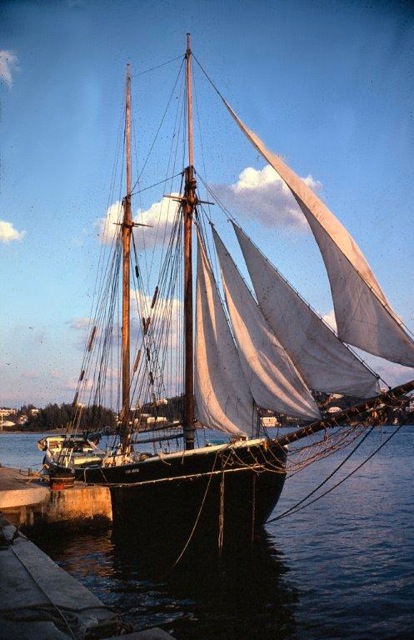
The Fletcher Christian in evening sun, Bermuda, April 1970
From then on we all worked incredibly hard equipping and fitting it out for the long journey. This included building very small and basic cabins with bunks for us all in what had been the boats cargo hold which had been used for holding grain and was just one big hole taking up much of the boat. Over the next few weeks we scraped, painted, sorted rigging and re caulked the planking on deck.
The one thing we didn't do before setting off was to sail it! Considering that most of the crew had never sailed a large boat let alone a very old oak one without a single winch on board with everything being done by muscle power alone, including the raising and lowering of those very large sails that you see in the photos, was not wise. Reiner Brenger, a young German who was bumming his way round the world and had been part of the crew that delivered the boat from Scandinavia, joined the crew. Tom and I later discovered that Reiner had not been charged the £1.00 a day that Tom and I had. This did not concern Tom and me at that stage but later in the voyage, and after I had left the boat, similar actions by Des caused much resentment.
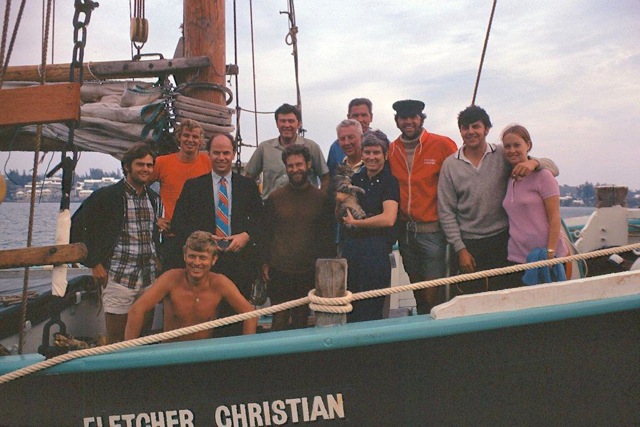
A couple of days before our departure in April 1970, a decision was made to move the boat from the dock at PW’s Marine Centre where we had been moored for some weeks in Hamilton Harbour, to the dock of the nearby Princess Hotel so that we could have a more salubrious departure. The old Grenna two piston engine was fired up and we started to move very cautiously towards the new dock which was quite close. We made it to just outside the Princess Hotel in front of a small welcoming crowd, bearing in mind this was the first time the boat had moved since arriving in Bermuda several weeks before.
Suddenly there was the most terrible crashing and grinding noise coming from the stern of the boat and an examination revealed that we had gone over and picked up the mooring buoy for the boat owned by the manager of the Princess Hotel which, fortunately, didn’t have his boat moored on it. Although the buoy was made of plastic, attached to it was a long length of chain which went down to a large concrete block on the sea bed. The chain had wrapped itself around the prop and dragged the concrete block to the surface at the back of the boat where it was firmly jammed. Needless to say the engine stopped and we started drifting across Hamilton Harbour, with no power and no means of controlling where we were going and with the potential to cause considerable damage to other boats etc.
After some time the Police launch turned up, and the crew, which I think included Les Tomlinson, were of course all good friends of ours, came alongside and with the help of other boats the Fletcher Christian was made fast to a buoy in the middle of the harbour. It was the night of our big send off party at the Police Club so we had to get ashore in the Police Boat so that we could attend. How we got back on board after the party I really couldn’t tell you. What’s new? I think the crew of the Police launch later found themselves in hot water with senior officers for their efforts to assist us.
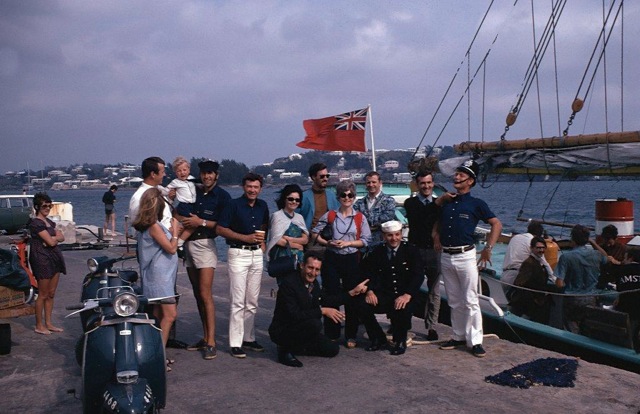
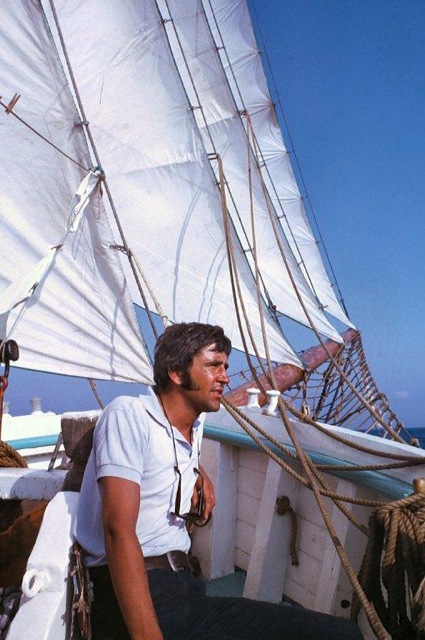
Mike relaxing in bow of Fletcher Christian
After several setbacks, before and after this incident, mostly connected with the old Grenna engine, which we needed to get into ports, motor through the Panama canal etc. we finally set sail in April of 1970 and so came to an end my 5 ½ years in Bermuda - sad but excited by what lay ahead.
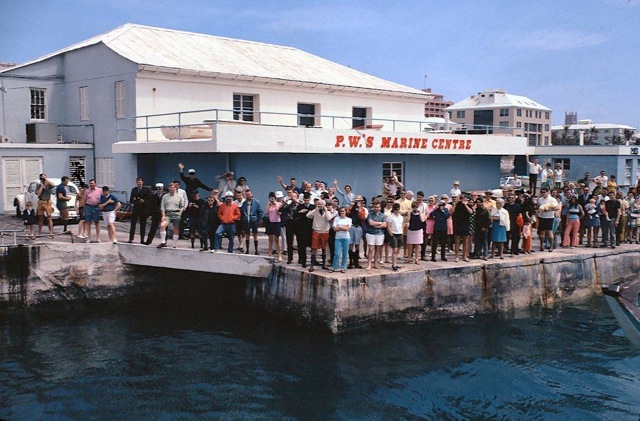
Crowd see off Fletcher Christian setting off on epic voyage!
Shortly after leaving Bermuda and whilst travelling through the North Shore channel the engine started belching smoke and making very worrying, “unengine-like” noises. It was clearly a terminal problem and Des told us that once turned off the engine would never go again. He asked us if we wanted to go back into Bermuda to sort the problem (new engine) or continue on to Puerto Rico and deal with the problem there. Despite it being foolhardy, to say the least, to undertake such a journey without any power, and of course the inexperienced crew, we all opted not to go back into Bermuda but to set sail for Puerto Rico. We had had enough delays and it would have been embarrassing, to put it mildly, to return after just a few hours.
Des and his wife had a cat called Jinx which they adored. When we had been moored at the dockside for the past few weeks working on the boat the engine had on several occasions been started up and when it was running it made an incredible noise, vibrating badly and causing the boat to shudder and shake from stem to stern and to the very top of the masts! I know this because I had once been at the top of the mast when the engine had been started up and I felt as if I was going to be flung off. On each occasion the engine had been started up whilst we were moored at the dockside, Jinx the cat had gone into hiding in the depths of the boat, obviously scared to death. Then, on each occasion that the engine was stopped Jinx would run through the boat, spring up onto the side of the boat and jump down onto the dockside where it obviously felt safer.
We were clear of Bermuda and a few miles out into the Atlantic when the time came to raise the sails prior to turning off the engine, never to go again. For the first time ever we raised the two mainsails and some of the headsails and the boat started to move smoothly and powerfully along under sail and there were smiles all round, now we were really off on our great adventure. After a short while the engine was switched off and yes - you’ve guessed it - a flash of tabby came through the boat up onto the side before ‘Jinx’ launched herself into the sea and not onto the dockside she had been expecting.
Des and his wife were mortified as they watched their beloved, loudly meowing, Jinx disappearing fast behind the boat which was gathering speed all the time. Bloody hell, we’ve only been at sea about two hours and now this. With that, Eric Sanderson, who had known the McSherrys better than the rest of us while in Bermuda, decided to dive off the stern of the boat in an attempt to rescue the bloody cat.
Oh shit, this is getting worse and the boat is now going very well with the cat some distance away and with Eric fast disappearing after it. Tom and I then decided we had better do something so we, with great difficulty, let down the little dinghy that hung on the davits at the back of the boat and started to row away from the boat which was still making good speed.
Remember, the sails had just gone up for the first time at sea and had never been taken down at sea. The added problem was that probably the three fittest, strongest people on board were no longer on board and the crew consisted of mainly women along with a journalist and an engineer. So now we had the cat, being chased by the fast swimming Eric who was in turn being chased by Tom and me rowing like hell, with the Fletcher Christian still making good speed in the opposite direction.
Eventually, Eric reached the cat, and Tom and I reached Eric and pulled him and the cat into the boat. After Eric, who really needed his brains testing for going overboard, had given the cat a very stiff talking to, Tom and I started to row towards the boat which was now a long way away but did seem to have been brought under control. After a long row we all got safely back on the boat and resumed our adventure.
Prior to leaving Bermuda, a Canadian called Adam who was always dressed well in blazer and white trousers and claimed to have quite a bit of sailing experience was taken on by Des as a member of the crew. The crew was split into two watches and he was put in charge of one watch with Tom, who had once crewed on a yacht from Antigua back to Bermuda in charge of the other watch. Not vast experience for sailing half way round the world.
Over the next day or so we made reasonable progress and started to learn more about the boat and how to operate it.
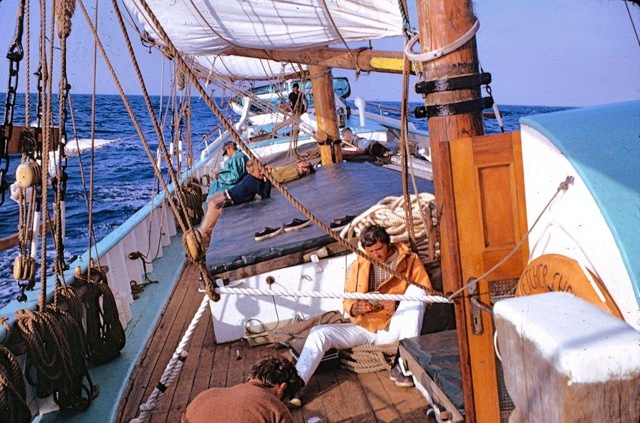
Relaxing in Mid Atlantic, Mike reading, Tom leaning on hatch.

View from the bowsprit
We then noticed that the sky on the horizon had become as black as thunder and that the wind was increasing and realised that a very bad storm was fast approaching us. Not a nice situation for an experienced crew in a modern yacht but us is in a very old Baltic Trader! Not good at all. We managed, with great difficulty, to get the main sails down before the storm hit us although it was really hairy as the wind increased as we worked to furl the sails. The storm stayed with us for several days and I have to say it wasn’t pleasant; in fact it was, at times, quite frightening.
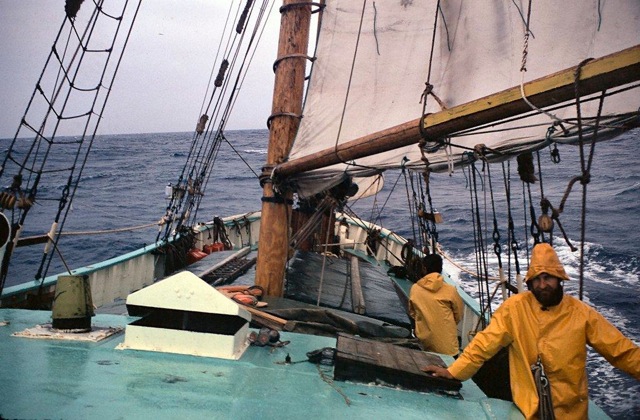
Mid-Atlantic, Fletcher Christian dipping, before rising, in rough seas following storm.
What did happen was that Adam, the Canadian, who knew how to tie knots properly, unlike the rest of us, had gone below and taken to his bunk during the storm. The result being that Des relieved him of his responsibilities for one of the watches and promoted me into that position, a dubious honour I feel and, considering my only previous sailing experience was in very small sailing boats probably not the most sensible promotion in marine history.
Well, we survived the storm and then had several days of reasonable sailing and things settled down nicely.
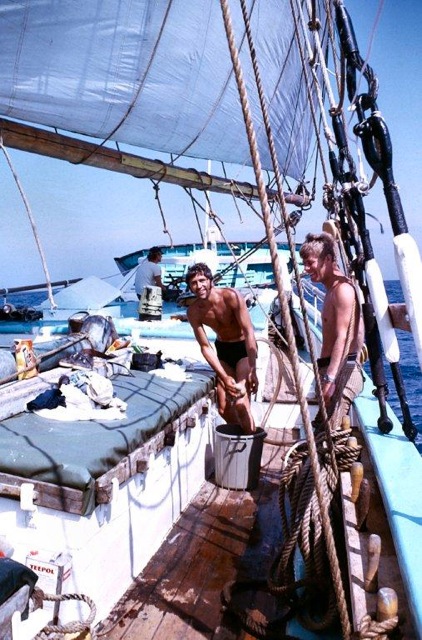
Mike washing, Tom waiting
Then the opposite happened, the wind slowly dropped to absolutely nothing and we became completely and utterly becalmed. At first this was a novelty but after several days of drifting around in the Atlantic and rolling from side to side it became less enjoyable. The sea was as calm as the face of a mirror and words from the ‘Ancient Mariner’ came to mind. “Day after day, day after day we stuck, nor breath nor motion; as idle as a painted ship on a painted ocean” etc etc. Under these circumstances progress would normally be made by using the engine, but we unfortunately had an engine in name only. At some point while becalmed several members of the crew jumped into the sea and were swimming about, I, on the other hand, was not too sure about the sense of doing this. We were hundreds and hundreds of miles from land with no means of communication and the thought of what might be lurking in the mile or so of Atlantic Ocean below us filled me with dread. What was I to do, I wanted to say that I had swum in the middle of the Atlantic, probably in the Bermuda Triangle with its implications, but I really wasn’t keen. In the end, not wishing to lose face, I jumped overboard, swam a short distance from the boat looked back and shouted to someone on board to take a photo, take a photo, quick, and once that was done I swam back to the boat and climbed aboard to safety while the other, braver souls, took their chance with giant squid, octopuses and huge sharks.
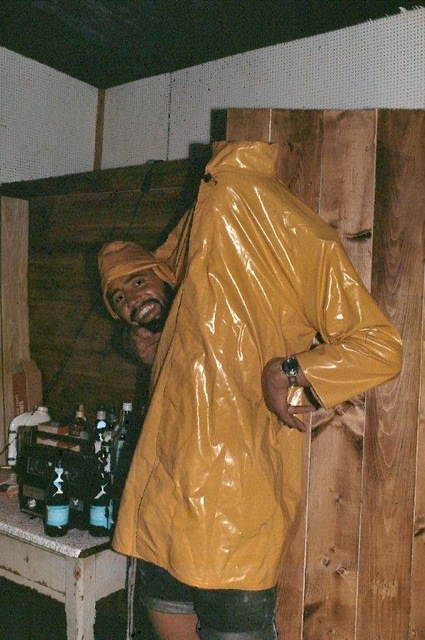
Messing about at sea.
Being becalmed had certainly put us well behind on our estimated journey time of, I think, ten days to Puerto Rico, and people in America who had money invested in the trip became concerned about what fate may have befallen us. Not sure if their concern was for us or their investment. It’s true that before our departure many experienced sailors had predicted that we would come to a watery end.
A few days after we got underway again after the becalming we were aware of the sound of an aeroplane and saw a US Coastguard aircraft coming towards us. They circled us and radio contact was made with them by Des. They were in fact searching for us, the alarm having been raised by the American backers. Des confirmed that we were the Fletcher Christian told them that we were all fine and that the reason for the delay in reaching Puerto Rico was down to the becalming. Des also told them that we would be in Puerto Rico in a few days and asked them to give us a ‘fix’ to confirm that we were where Des thought we were from his efforts with a sexton and charts. They gave us the co-ordinates and then flew off. Des went straight to his charts and after several minutes determined that our position, as given by the crew of the Coastguard plane, was many miles away from where Des had thought we were.
An urgent radio call was then made to the plane and we just got through to them before they flew out of range. They were asked if a mistake could have been made when giving us our position and after a period of silence they said it is possible and said they were returning to us. When they again arrived over us and again gave us a ‘fix’, to the relief of us all, it put us almost exactly where Des had thought we were. Well done Des. We then had some good sailing under full sail which put us quite quickly very close to Puerto Rico but our troubles on the first stage of our trip had not ended yet.
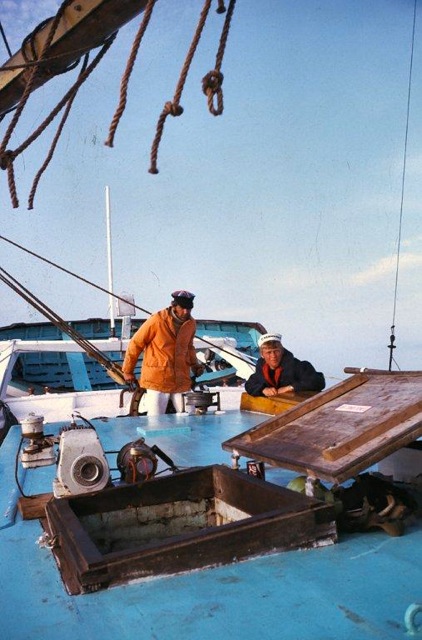
Mike at wheel, Tom in hatch.
The weather closed in and visibility became very poor. We would have to lower our sails which would be normal approaching port but we of course didn’t have an engine so would have been a drifting danger to ourselves and other shipping. In view of this, the US Coastguard in Puerto Rico, who we were now in radio contact with, decided that they would come out and take us under tow.
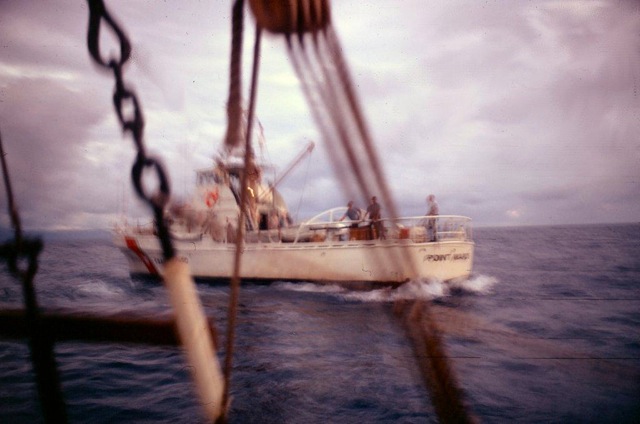
US Coastguard arrives to tow us into Puerto Rico, May 1970
To be continued.
Last year, I had digitalised over one hundred slides covering the time that I was involved with the Fletcher Christian and some of them are included in this article. However, I have uploaded them all (over 100) to ‘Shutterfly’ so if anyone would like to see the rest I can easily share them via ‘Shutterfly’.
